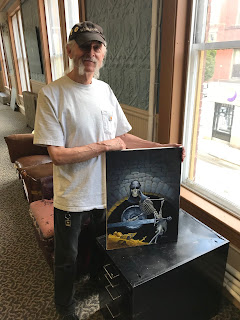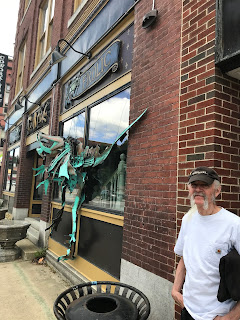 |
| Cover art of Flame and Crimson |
--Robert E. Howard, "Queen of the Black Coast."
I have loved the sword-and-sorcery genre ever since I was a kid, going back at least some 35 years I’d warrant. If my memory is correct it began with a fortuitous find of a treasure-trove of The Savage Sword of Conan magazines, a story which I detailed here a while back on The Silver Key. Since then sword-and-sorcery has been a huge part of my reading life, informed my one-time obsession with Dungeons and Dragons and fantasy role-playing, and even led me to seek out some heavy metal bands that proudly fly the sword-and-sorcery banner.
So I figured, why not write a book on the subject?
I have, and the result is Flame and Crimson: The rise, fall, and rebirth of sword-and-sorcery.
It’s due to be published at the end of the year by Pulp Hero Press.
Pulp Hero Press is so new it
doesn’t even have a website yet. But it has published a handful titles of significant
interest to fans of S&S, and Robert E. Howard in particular. These include Barbarian Life: A Literary Biography of
Conan the Barbarian by Roy Thomas, Robert
E. Howard: A Literary Biography by David C. Smith, Western Weirdness and Voodoo Vengeance by Fred Blosser, and Savage Scrolls: Scholarship from the
Hyborian Age, also by Blosser.
Just this past Friday I sent the files over to the
publisher, but there is more work to be done. I’ll be seeing them again
post-edit. The plan is to have the book in circulation and available for
purchase by early December.
I have a written a lot during my 46 years on the planet. D&D
adventures and ridiculous made up stories I and my friends wrote for kicks.
Essays and term papers. Spiral notebooks full of book reviews I hand wrote
during the pre-internet days. I have worked for a daily newspaper and covered
local news, town politics, and high school sports on deadline, including high
school football for 22 years and counting. I’ve written for various fantasy
websites and blogs, including a few hundred posts here at the Silver Key of
course, as well as essays appearing in a handful of print journals. But I’ve
never written anything long form. Until now.
Flame and Crimson
was a ton of work, which I’ll detail in full later. Suffice to say it was a lot
of research. I had many holes to fill in my reading, a lot of old books that I had
to track down and buy. I was able to get a hold of the entire run of the
REH/sword-and-sorcery fanzine Amra. I watched a lot of bad sword-and-sorcery
films. Then it was outlining, and revising the outline. The table of contents
underwent many revisions and changes. I wrote, and revised, and re-revised, and
edited, and wrote some more. I started work on the book some six years ago but had
to put it on hold for the better part of a year. But I never gave up hope. I
spent more nights then I care to count plugging away on the computer, an hour
here or there as time allowed. I’ve had some help along the way by an expert or
two on the subject, better read than I. Finally, it’s (almost) fit to print.
Flame and Crimson
is an academic study of the genre, heavily referenced and with a lengthy works
cited (I see MLA citations in my sleep). Anyone who has looked under the hood
of sword-and-sorcery has realized the dearth of good published material on the
genre itself. Lin Carter’s Imaginary
Worlds has a couple chapters on it. Some anthologies contain working
definitions, but these are typically breezy and lightly sketched. You can find
articles online easily enough, but in the main these are informal, subjective,
and often well-intentioned, but misleading. Sword-and-sorcery as a term is still
used to describe works as diverse as The Lord of the Rings, Forgotten Realms tie-in
novels, and the Mists of Avalon.
 |
| Tom's return to sword-and-sorcery. |
But while I wanted to add some degree of academic and
critical rigor to the subgenre I didn’t want to write something dry and pedantic.
One of my goals was to try and tell an exciting tale of non-fiction. Sword-and-sorcery
has a story of its own to tell, of a confluence of pulp talent, a mercurial
renaissance, a staggering commercial fall, and a second life in the popular
culture. I wanted to write the kind of academic study that I’d want to read—informative,
but also entertaining. I hope I have succeeded, or at least have written something
that will provoke reactions, discussion, and get people interested in exploring
my favorite subgenre of fantasy fiction.
I am super happy with the cover, which I’m revealing here
for the first time. I’ve been detailing my experiences with veteran science
fiction, fantasy, and sword-and-sorcery illustrator Tom Barber, and I’m pleased
to say he has painted the cover of Flame
and Crimson. I could not be more pleased with the work. It’s simple, stark,
and evocative. Tom is a legend with a tremendous body of work, and I’m not sure
I’m worthy of his talents.
I cannot even begin to describe how exhilarated I am to have
written this book. And to soon be sharing it with you.



























